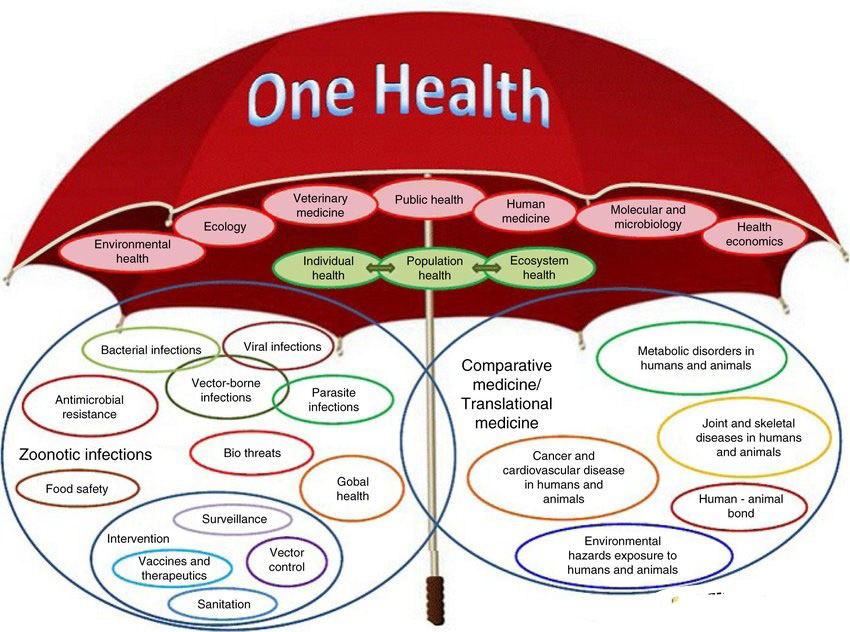By Dr Than Lwin Tun
“ONE Health” is the collaborative efforts of multiple disciplines working locally, nationally, and globally to attain optimal health for people, animals, and our environment. One Health lens is used to address the underlying factors of human diseases through collaborative, multisectoral efforts.
Global: An enabling environment for One Health implementation through strategic political advocacy, norms and standards setting, and development of global resources and tools.
Regional: Robust regional platforms and networks are established and strengthened to facilitate the exchange of lessons learned and best practices in One Health.
Country: The One Health approach is mainstreamed into national policies and strategies with effective and strengthened multisectoral mechanisms to coordinate One Health actions.
Commun i t i e s : Commun i ties are empowered through education and training to adopt good One Health practices for imp r o v e d h e a l t h a n d well-being.
Ru d o l f Virchow, the father of cellular pathology and who coined the term “zoonosis”, told that “Between animal and human medicine there are no dividing lines — nor should there be. The object is different, but the experience obtained constitutes the basis of all medicine.”
Ronald M Davis, President, American Medical Association Director, Center for Health Promotion & Disease Prevention, said: “I’m delighted that the AMA House of Delegates has approved a resolution calling for increased collaboration between the human and veterinary medical communities and I look forward to seeing a stronger partnership between physicians and veterinarians. Emerging infectious diseases, with the threats of cross-species transmission and pandemics, represent one of many reasons why the human and veterinary medical professions must work more closely together.”
The WHO One Health Initiative Vision: A world able to prevent, predict, detect, and respond to health threats as well as to empower different sectors to adopt a One Health approach, bringing the health of people, animals, and the environment all into focus.
Our Mission: to mainstream the One Health approach into national policy and strategy, ensuring that health interventions and programmes are designed with a One Health lens to address the underlying factors of human diseases through collaborative, multisectoral efforts.
Key Components of One Health
Ø Interdisciplinary Collaboration:
Involves professionals from diverse fields such as medicine, veterinary science, environmental science, and public health.
Encourages communication and collaboration among different sectors.
Ø Surveillance and Research:
Emphasizes the need for integrated surveillance systems to monitor health trends and outbreaks across species.
Supports research on zoonotic diseases, environmental factors, and health impacts.
Ø Education and Advocacy:
Promotes awareness of the interconnectedness of health issues among the public and policymakers.
Encourages educational programs that train future professionals in a One Health approach.
Ø Areas of Focus
Zoonotic Diseases: Diseases that are transmitted between animals and humans (e.g., COVID-19, Ebola).
Antimicrobial Resistance: Addresses the overuse of antibiotics in humans and animals and its impact on health.
Environmental Health: Examines the effects of environmental changes, such as pollution and climate change, on health.
Ø Global Initiatives
WHO and OIE Collaboration: The World Health Organization (WHO) and the World Organization for Animal Health (OIE) work together to enhance One Health strategies.
Food Security: Initiatives to ensure safe food production and distribution, recognizing the links between agriculture, animal health, and human health.
Biodiversity Conservation: Protecting ecosystems to reduce the risk of emerging infectious diseases.
Ø Benefits of One Health
Improved Disease Prevention: Early detection and response to health threats can lead to more effective control measures.
Cost-Effective Solutions: Integrating efforts can lead to more efficient use of resources and funding.
Enhanced Public Awareness: Increased understanding of the links between health sectors can lead to better public health outcomes.
Ø Challenges
Systems: Existing health systems often operate independently, making collaboration difficult.
Funding and Resources: Securing adequate funding for One Health initiatives can be challenging.
Policy Integration: Aligning policies across sectors requires significant effort and negotiation.
In addition, One Health initiatives are vital for addressing complex health challenges in our interconnected world. By fostering collaboration and integrating approaches across disciplines, we can better anticipate and respond to health threats affecting humans, animals, and the environment.
References
-https://onehealthinitiative. com
- https://cdn.who.int


